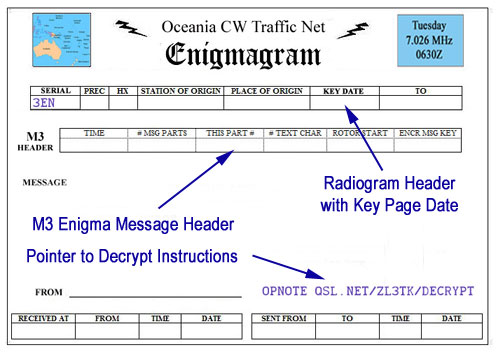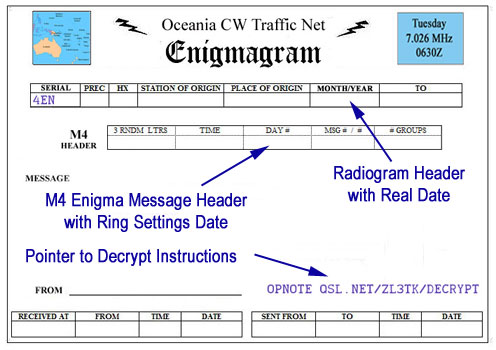|
HEADER, first row.
This row was not used by the Wehrmacht,
but is needed today to identify the stations and particularly the
Key Page date, which was already known to WW2 stations from the
distributed code books.
SERIAL defines the sending station's
serial number system, separately from regular unencrypted traffic.
PREC (in the usual format) defines
precedence, though unikely to be anything other than R for Routine.
HX (in the usual
format) instucts receiving station how the message should be handled
STATION OF ORIGIN call sign
PLACE OF ORIGIN (in the usual format)
KEY DATE DD-MMM-YYYY defines one row in the Daily
Key code pages
TO call sign
HEADER, second row.
Unique to the M3
TIME four digits in 24-hour format specific to the key
date in the first row.
# MSG PARTS defines messages to be sent dealing with one
subject e.g. 3TLE = three in total
THIS PART # defines this message's position
in the sequence, e.g. 2TLE = two of three messages
# TEXT CHARACTERS total letter count of the message
text. e.g. count 5-letter groups and multiply by five.
ROTOR START three random letters, the first
trigram which is visible through the rotor windows.
ENCR MSG KEY three letters, the thrid trigram, the
result of encrypting the first trigram with a second trigram
MESSAGE up to
forty 5-letter groups, 200 characters.
FROM call sign of the sending station.
OPNOTE provides URL pointing to the decryption
resource
MANAGEMENT FIELDS (in the usual local time/date format)
used for record keeping
|
|
HEADER, first row.
This row was not used by the Kriegsmarine,
but is needed today to identify the stations.
SERIAL defines the sending station's serial number system,
separately from regular unencrypted traffic.
PREC (in the usual format) defines
precedence, though unikely to be anything other than R for Routine.
HX (in the usual
format) instucts receiving station how the message should be handled
STATION OF ORIGIN call sign.
PLACE OF ORIGIN (in the usual format)
MONTH/YEAR local date data
TO call sign
HEADER, second row.
Unique to the M4
TIME four digits in 24-hour
format UTC
DAY # defines which day of the month to use
for inner and outer ring settings, etc.
MSG # / # defines this message number
relative to the total number of messages on the same subject
# GROUPS total number of four letter groups
MESSAGE up to ffifty 4-letter groups, 200
characters.
FROM call sign of the sending station.
OPNOTE provides URL pointing to the decryption
resource
MANAGEMENT FIELDS (in the usual local time/date format)
used for record keeping
|

